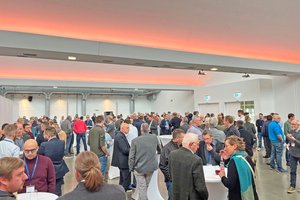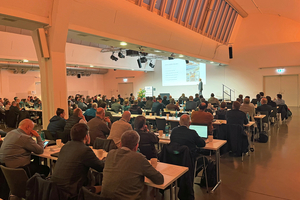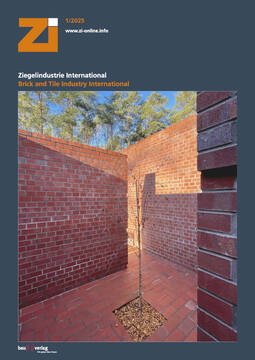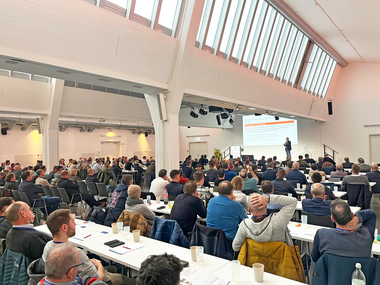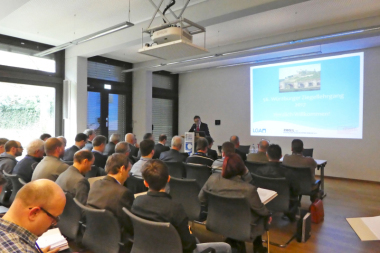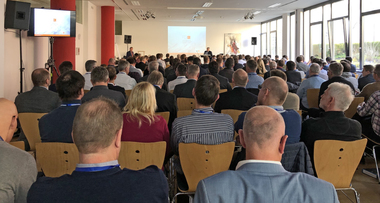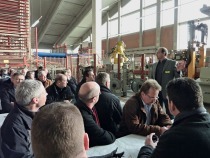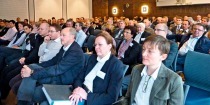Review of the 61st Würzburg brickmaking course
On 3 and 4 December, the largest meeting of the German brick and tile industry, the Würzburg Brick and Tile Training Course, took place for the 61st time. For the first time, the event was chaired by Andreas Klarmann, successor to Joachim Deppisch. Around 200 registrations for participation were received and the rows in the Vogel Convention Centre in Würzburg were well filled - for Klarmann, proof of the great interest in exchange and information, even in the current very tense economic situation in the brick and tile industry. In his welcoming address, Klarmann was particularly pleased with the internationality of the visitors, who came not only from German-speaking countries but also from the Benelux countries and Scandinavia. The programme included 21 specialist presentations.
Programme on Tuesday, 3 December 2024 - Overarching topics
David Ostendorf, Technical Managing Director of the Federal Association of the German Brick and Tile Industry (BVZi), opened the event on behalf of Managing Director Attila Gerhäuser, who was attending the European Ceramic Days in Brussels. Ostendorf outlined the situation, the current challenges facing the construction industry and gave a cautiously optimistic outlook.
Dr Tillmann Prinz, Federal Managing Director of the Bundesarchitektenkammer e. V. (Federal Chamber of Architects), spoke about the “Future of new residential construction”, including the type-e building and the potential of serial construction for rapid residential construction.
Dipl.-Ing. Juliane Nisse, BVZi, discussed the “Life cycle assessment of buildings in the context of new construction funding” and emphasised the growing importance of the former for the latter, particularly in light of the European Buildings Directive.
Dipl.-Ing. Katharina Armbrecht, BVZi, presented “Current developments in the environment and energy policy”: the revision of the IE Directive and the BREF ceramics, CO2 emissions trading, the development of grid charges and the platform for waste heat prescribed by the Energy Efficiency Act.
The “Safety requirements for operators of industrial gas plants and thermal processing plants” were explained by Andreas Guntermann from swb Services AG & Co. KG in Bremen. The relevant provisions and regulations are DVGW and DIN EN 746-2. Swb offers multiple choice quick tests online for 6 areas: Swb.de/quick-check.
For “Optimisation through energy management system and battery storage” Michael Riebesecker, Consolinno Energy GmbH in Regensburg, and Christian Mayr, Allgäu Batterie GmbH & Co. KG in Haldenwang, presented their products: the AI-supported FlexA energy management system and battery storage systems with lithium iron phosphate cells.
Dipl.-Ing. (FH) Rainer Hüsing, KELLER HCW GMBH in Ibbenbüren, reported on “Electrification from the perspective of the plant manufacturer”. The approaches presented were: Resistance heating, hot air generation with hot gas generators, induction heating in pipework, heat pumps and energy recovery as well as microwaves. The challenges are scale-up, implementation in system technology, safety and cost-effectiveness. Finally, Hüsing warned that surface properties from reducing fires are not possible with electrically generated heat.
Thomas Alten from Keramischer OFENBAU GmbH in Hildesheim gave a report on “eTO technology, results and experiences”. An electric kiln for sanitary ceramics has been in operation at Laufen’s Gmünden plant for a year now. Among other things, it has been shown that a different kiln atmosphere with more oxygen and less water leads to lower alkali reduction. The exhaust gas volume is 20 per cent lower than a conventional tunnel kiln.
The agenda was rounded off with a presentation by Alexander Kulesa from neustrom GmbH in Berlin, who presented an AI pilot for controlling and regulating electricity in real time.
To round off the first day, the hosts invited the participants to the Bürgerspital Würzburg. Over a mulled wine in the festively decorated courtyard and a richly laid table in the restaurant, it was easy to get into conversation. As usual, many ended the evening in one of the pubs in the city centre.
Programme on Wednesday, 4 December 2024 - Production topics and special topic on clay construction
The first lecture of the second day was a “Premiere for bricks from the sludge pond - the path to a technological leap”. EurGeol Dr Lutz Krakow from KRAKOW Rohstoffe GmbH in Göttingen presented filter cake from rock washing as a clay deposit suitable for brick production.
The availability and requirements of “Calcined Westerwald clays as highly reactive cement constituents” were discussed by Dr C. Piribauer from Stephan Schmidt KG in Dornburg.
Under the title “3D design, material and energy savings in existing extrusion lines with z.trusion®”, Mark Jansson Kragh from Z-Trusion, Varberg, presented a new tool for moulding on the Z-axis using rotating elements. This technology is used, for example, by Tonality.
Dr Jens Petzold and M. Sc. Klaus Hantzsch, from KI Keramik-Institut GmbH in Meißen, presented “Alternative shaping processes for classic structural ceramics”: pressure die casting and isostatic press forming.
Dr.-Ing. Rigo Giese, Institut für Ziegelforschung Essen e. V. (IZF), spoke on the “Use of ammonia (NH3) as a substitute fuel for decarbonisation - challenge and feasibility - NH3 bricks” (see ZI 6/24, p. 20ff.).
Alexander Jahn (M. Eng.), innovatherm | Prof. Dr. Leisenberg GmbH + Co. KG in Butzbach, presented reports on reference projects for dosing gas and combustion air to reduce CO2.
In his second lecture, Rainer Hüsing presented an “Energy-optimised combustion concept based on a specific example” and highlighted the various options for increasing energy efficiency in existing systems and gave an outlook on the possibilities for designing new systems.
“ERP systems”, software for enterprise resource planning, were in the focus of the presentation by Dipl.-Ing. Andreas Hougardy, SOFTBAUWARE GmbH from Langen. The company’s own software and associated services are already being used by some German brick manufacturers.
Alexander Gorlt, member of the management team at Thermoplan Anlagenbau Elektrotechnik Verfahrenstechnik GmbH in Olching, spoke about “Camera systems and quality inspection systems - automation of the future”. He focussed on the Bluebox inspection system for roof tiles.
Dr Denny Mathew Alex from IZF discussed the “Modelling and simulation of the tunnel kiln process” (see page 43 of this issue).
Prof Dr Christof Ziegert, ZRS Ingenieure GmbH in Berlin, discussed “Load-bearing clay block masonry according to DIN 18940 up to building class 4”.
“Sustainable aspects in the production of earth building materials” were presented by Dr Anne Tretau, MFPA Weimar.
The “Development of a separable mortar joint for brick masonry” was explained by Dipl.-Ing. Alexander Freyburg, MFPA Weimar.
In the last lecture of the 61st Würzburg Brick and Tile Course, Alexander Winkel (IZF) spoke on the “Recarbonation of brick material” (see p. 41 of this issue).
To conclude, Andreas Klarmann thanked all the speakers and participants and announced the 62nd Würzburg Brick and Tile Course for 2 and 3 December 2025.

